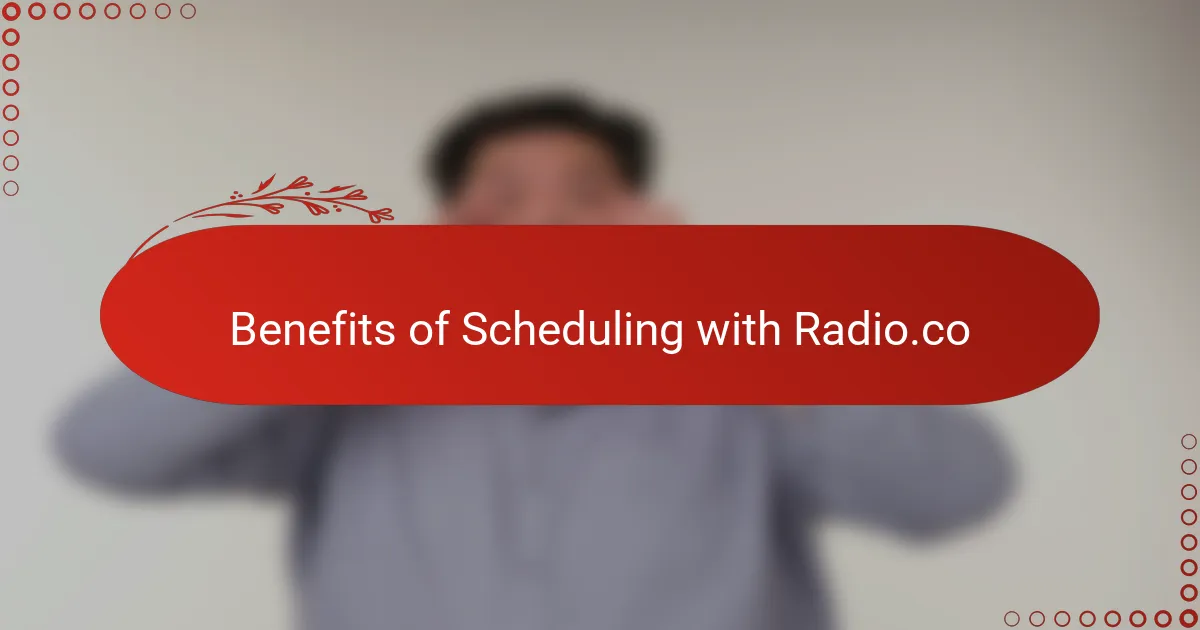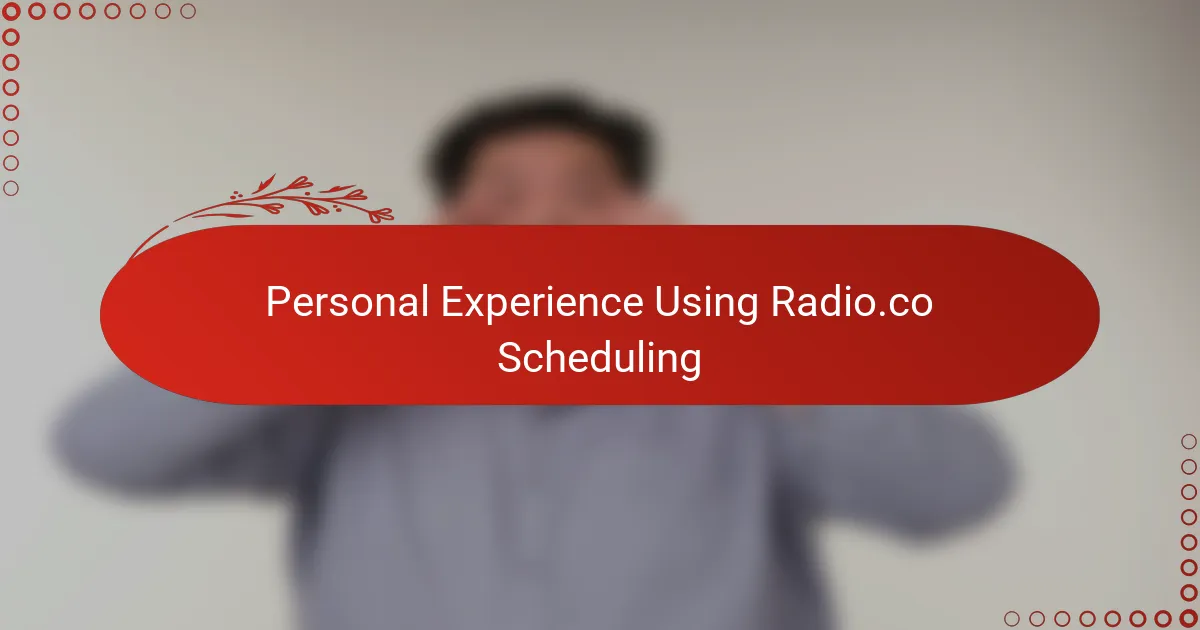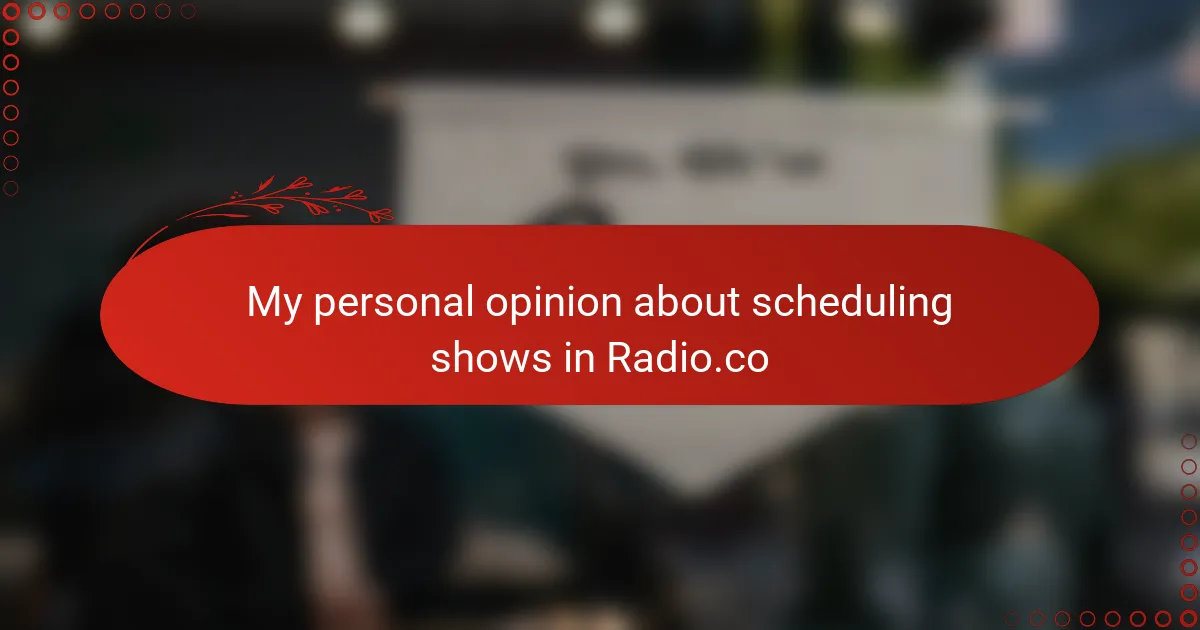Key takeaways
- Radio broadcasting combines creativity and structure, requiring a balance between spontaneity and precise timing for a seamless listener experience.
- Effective show scheduling enhances listener engagement and loyalty, with flexibility being essential for adapting to last-minute changes.
- Radio.co offers user-friendly automation tools and detailed analytics, allowing broadcasters to efficiently manage content and understand audience patterns.
- Success in scheduling involves thoughtful timing for peak listener hours, consistency in programming, and allowing buffer times between shows to avoid stress from technical issues.

Understanding Radio Broadcasting Basics
When I first dipped my toes into radio broadcasting, I quickly realized it’s more than just speaking into a microphone. It’s about connecting with an audience, managing timing, and creating a seamless flow that keeps listeners hooked. Have you ever thought about how much precision actually goes into making a live show feel effortless?
Understanding the basics means grasping elements like programming schedules, audio equipment, and signal transmission—all working together behind the scenes. From my experience, even a small technical hiccup can throw off the entire vibe of a broadcast, and that’s where knowing your foundations pays off big time.
What fascinates me most is how radio combines creativity with structure. There’s a rhythm to it, balancing spontaneity with strict timing. This balance is what makes radio both an art and a science, and it’s what drew me deeper into the world of broadcasting.

Overview of Scheduling Shows in Radio
Scheduling shows in Radio is where the magic really starts for me. It’s more than just placing time slots on a calendar; it’s about weaving a story throughout the day that keeps listeners coming back. Have you ever noticed how a well-timed show transition can make the entire broadcast feel smooth and natural? I’ve seen firsthand how thoughtful scheduling lifts a station’s energy and listener loyalty.
One thing I’ve learned is that flexibility within the schedule is just as important as the plan itself. When unexpected changes pop up, being able to adapt without missing a beat separates a good broadcaster from a great one. It reminds me of a live show I once worked on, where a last-minute guest appearance meant reshuffling the lineup on the fly—and the audience never guessed a thing.
Ultimately, scheduling shows is a balancing act of art and logistics. Getting the right mix of content, timing, and pacing isn’t easy, but when it clicks, it creates an immersive experience that feels both planned and spontaneous. It’s that dynamic that makes working with radio schedules so challenging and rewarding in my book.

Key Features of Radio.co Platform
What stands out to me about Radio.co is how user-friendly its scheduling interface is. I remember the first time I logged in—I could easily drag and drop shows into slots without fumbling through complicated menus. Isn’t that a relief for anyone juggling multiple programs?
Another feature I appreciate is the automation tools that let you set up playlists and live shows ahead of time. It’s like having a reliable assistant who never sleeps, ensuring your content airs exactly when planned, even if you can’t be there in person. Have you ever wished for that kind of safety net during a busy day?
Plus, Radio.co offers detailed analytics that give insights into listener patterns. From my experience, this kind of data is invaluable because it helps tailor schedules to what your audience truly wants, making each broadcast more engaging. Don’t you think knowing when your listeners tune in most can transform how you plan your shows?

Benefits of Scheduling with Radio.co
One of the biggest benefits I’ve found with scheduling shows on Radio.co is the peace of mind it brings. Knowing that my shows will air automatically, without me having to be glued to the controls, takes so much pressure off. Have you ever been stressed about missing a live slot? Radio.co’s automation smoothed that out completely for me.
I also love how intuitive the scheduling tools are. There was a time when I had a packed week of content to line up, and Radio.co’s drag-and-drop feature made it surprisingly easy to organize everything quickly. That kind of efficiency lets me focus more on creative content instead of wrestling with complex software.
Another aspect that really struck me is how the platform’s scheduling flexibility lets me adapt on the fly. When last-minute changes happen, I can rearrange shows seamlessly without losing listeners or disrupting the flow. It’s a game-changer for anyone who knows that in radio, plans often change in an instant.

Personal Experience Using Radio.co Scheduling
Using Radio.co’s scheduling has honestly transformed how I manage my broadcast days. I remember the first time I set up a week’s worth of shows—it felt almost effortless, like I’d finally found a system that understands the chaos behind the scenes. Have you ever experienced that relief when a tool just clicks perfectly with your workflow? That’s exactly what happened to me.
There was this one hectic week when I had to shuffle my entire lineup because a guest canceled at the last minute. Usually, such a scramble would give me a headache, but with Radio.co, I quickly dragged and dropped new segments into place without missing a beat. I felt genuinely in control, even amid the unpredictability of live radio.
What really struck me is how the platform balances power with simplicity. Despite its advanced features, it never felt overwhelming. Instead, I found myself focusing more on crafting interesting content rather than battling the software. Doesn’t that make you wonder why more tools can’t be this intuitive?

Tips for Effective Show Scheduling
One tip I always keep in mind is to block out prime listener hours thoughtfully. Isn’t it obvious that your best content should shine when most ears are tuned in? For me, placing flagship shows during peak times boosted engagement and gave the station a real buzz.
I’ve also learned that consistency matters more than you’d think. Having a steady schedule makes listeners feel they’re part of something reliable. When my audience knows exactly when to catch their favorite show, it builds trust and anticipation—kind of like meeting an old friend at the same café every week.
Finally, don’t underestimate the power of buffer times between shows. Early on, I used to cram schedules tight, thinking it was efficient. But surprise technical glitches or overrunning segments taught me that a little breathing room saves a lot of stress—and keeps broadcasts smooth. Have you ever had a show overrun and felt that panic? A smart schedule can prevent that entirely.
